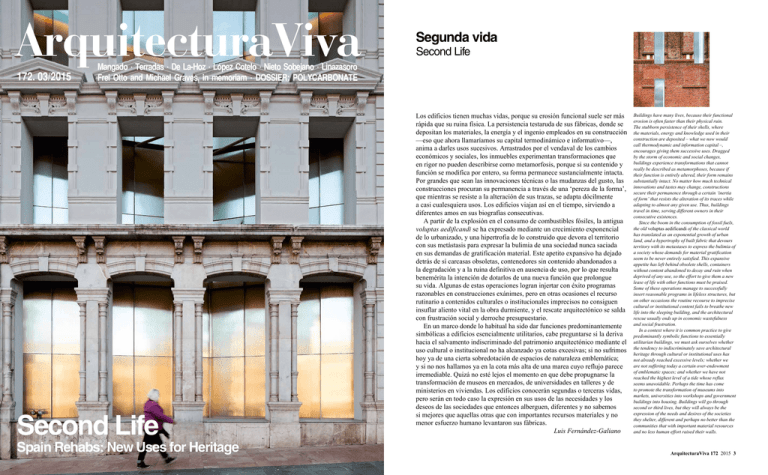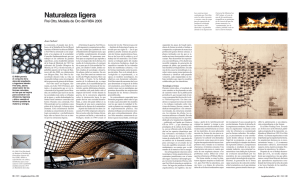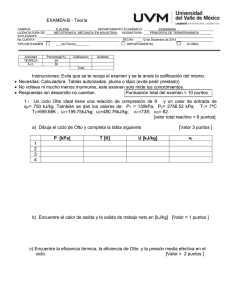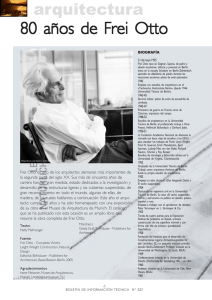Second Life - Arquitectura Viva
Anuncio

ArquitecturaViva 172. 03/2015 Segunda vida Second Life Mangado · Terradas · De La-Hoz · López Cotelo · Nieto Sobejano · Linazasoro Frei Otto and Michael Graves, in memoriam · DOSSIER: POLYCARBONATE Second Life Spain Rehabs: New Uses for Heritage Los edificios tienen muchas vidas, porque su erosión funcional suele ser más rápida que su ruina física. La persistencia testaruda de sus fábricas, donde se depositan los materiales, la energía y el ingenio empleados en su construcción —eso que ahora llamaríamos su capital termodinámico e informativo—, anima a darles usos sucesivos. Arrastrados por el vendaval de los cambios económicos y sociales, los inmuebles experimentan transformaciones que en rigor no pueden describirse como metamorfosis, porque si su contenido y función se modifica por entero, su forma permanece sustancialmente intacta. Por grandes que sean las innovaciones técnicas o las mudanzas del gusto, las construcciones procuran su permanencia a través de una ‘pereza de la forma’, que mientras se resiste a la alteración de sus trazas, se adapta dócilmente a casi cualesquiera usos. Los edificios viajan así en el tiempo, sirviendo a diferentes amos en sus biografías consecutivas. A partir de la explosión en el consumo de combustibles fósiles, la antigua voluptas aedificandi se ha expresado mediante un crecimiento exponencial de lo urbanizado, y una hipertrofia de lo construido que devora el territorio con sus metástasis para expresar la bulimia de una sociedad nunca saciada en sus demandas de gratificación material. Este apetito expansivo ha dejado detrás de sí carcasas obsoletas, contenedores sin contenido abandonados a la degradación y a la ruina definitiva en ausencia de uso, por lo que resulta benemérita la intención de dotarlos de una nueva función que prolongue su vida. Algunas de estas operaciones logran injertar con éxito programas razonables en construcciones exánimes, pero en otras ocasiones el recurso rutinario a contenidos culturales o institucionales imprecisos no consiguen insuflar aliento vital en la obra durmiente, y el rescate arquitectónico se salda con frustración social y derroche presupuestario. En un marco donde lo habitual ha sido dar funciones predominantemente simbólicas a edificios esencialmente utilitarios, cabe preguntarse si la deriva hacia el salvamento indiscriminado del patrimonio arquitectónico mediante el uso cultural o institucional no ha alcanzado ya cotas excesivas; si no sufrimos hoy ya de una cierta sobredotación de espacios de naturaleza emblemática; y si no nos hallamos ya en la cota más alta de una marea cuyo reflujo parece irremediable. Quizá no esté lejos el momento en que debe propugnarse la transformación de museos en mercados, de universidades en talleres y de ministerios en viviendas. Los edificios conocerán segundas o terceras vidas, pero serán en todo caso la expresión en sus usos de las necesidades y los deseos de las sociedades que entonces alberguen, diferentes y no sabemos si mejores que aquellas otras que con importantes recursos materiales y no menor esfuerzo humano levantaron sus fábricas. Luis Fernández-Galiano Buildings have many lives, because their functional erosion is often faster than their physical ruin. The stubborn persistence of their shells, where the materials, energy and knowledge used in their construction are deposited – what we now would call thermodynamic and information capital –, encourages giving them successive uses. Dragged by the storm of economic and social changes, buildings experience transformations that cannot really be described as metamorphoses, because if their function is entirely altered, their form remains substantially intact. No matter how much technical innovations and tastes may change, constructions secure their permanence through a certain ‘inertia of form’ that resists the alteration of its traces while adapting to almost any given use. Thus, buildings travel in time, serving different owners in their consecutive existences. Since the boom in the consumption of fossil fuels, the old voluptas aedificandi of the classical world has translated as an exponential growth of urban land, and a hypertrophy of built fabric that devours territory with its metastases to express the bulimia of a society whose demands for material gratification seem to be never entirely satisfied. This expansive appetite has left behind obsolete shells, containers without content abandoned to decay and ruin when deprived of any use, so the effort to give them a new lease of life with other functions must be praised. Some of these operations manage to successfully insert reasonable programs in lifeless structures, but on other occasions the routine recourse to imprecise cultural or institutional content fails to breathe new life into the sleeping building, and the architectural rescue usually ends up in economic wastefulness and social frustration. In a context where it is common practice to give predominantly symbolic functions to essentially utilitarian buildings, we must ask ourselves whether the tendency to indiscriminately save architectural heritage through cultural or institutional uses has not already reached excessive levels; whether we are not suffering today a certain over-endowment of emblematic spaces; and whether we have not reached the highest level of a tide whose reflux seems unavoidable. Perhaps the time has come to promote the transformation of museums into markets, universities into workshops and government buildings into housing. Buildings will go through second or third lives, but they will always be the expression of the needs and desires of the societies they shelter, different and perhaps no better than the communities that with important material resources and no less human effort raised their walls. ArquitecturaViva 172 2015 3 Arquitectura Viva.com 172. 03/2015 Segunda vida Director Luis Fernández-Galiano Director adjunto José Jaime S. Yuste Diagramación y redacción Cuca Flores Eduardo Prieto Laura Fernández Miguel Fernández-Galiano Maite Báguena Raquel Vázquez Jorge Martín Pablo Canga Miguel de la Ossa Alicia Gutiérrez Mar Pérez-Ayala Coordinación editorial Laura Mulas Gina Cariño Producción Laura González Jesús Pascual Administración Francisco Soler Suscripciones Lola González Distribución Mar Rodríguez Publicidad Cecilia Rodríguez Teresa Maza Redacción y administración Arquitectura Viva SL Aniceto Marinas, 32 E-28008 Madrid Tel: (+34) 915 487 317 Fax: (+34) 915 488 191 AV@ArquitecturaViva.com www.ArquitecturaViva.com Precio: 15 euros © Arquitectura Viva 172. 03/2015 Second Life En breve. Frei Otto, Premio Pritzker un día después de morir; Apple encarga 5 Actualidad Frei Otto, Pritzker póstumo Sedes tecnológicas De Maduro a Marino Restauración o rehabilitación. Igual que lo hace la población humana, la de los edificios envejece, en especial tras la larga crisis que, sobre todo en España, ha parado la construcción de nueva planta. En este contexto, la restauración del patrimonio con valor artístico, ya sea histórico o moderno, se complementa cada vez más con intervenciones de rehabilitación que transforman los usos de los edificios y los dotan con una segunda vida. Aquí damos cuenta de este fenómeno a través de un artículo y una selección de obras recientes. De la mano de Alfonso Muñoz Cosme, el artículo analiza, con motivo del segundo centenario del nacimiento de Viollet-le-Duc, la fictica polémica que este mantuvo con John Ruskin, y recoge su influencia en las teorías de la restauración posteriores. Por su parte, la selección presenta seis rehabilitaciones ejemplares en España: en Oviedo, Francisco Mangado acaba de terminar la ampliación del Museo de Bellas Artes de Asturias, cuya envolvente es ahora una suerte de palimpsesto; en Barcelona, Terradas Arquitectos han transformado las espléndidas Atarazanas Reales en una dotación cultural; en Córdoba, Rafael de La-Hoz ha intervenido sobre un teatro construido por Luis Gutiérrez Soto; en Granada, Víctor López Cotelo ha convertido un hospital militar en una escuela de arquitectura; en Las Palmas, Nieto y Sobejano han dado un uso cultural a un viejo fortín; y en Teruel, José Ignacio Linazasoro ha transformado la plaza de los Amantes. 11 Alfonso Muñoz Cosme Historias de la restauración 11 Alfonso Muñoz Cosme Stories of Restoration Telón de piedra 18 Francisco Mangado Museo de Bellas Artes, Oviedo Fajones y formeros 22 Terradas Arquitectos Museo Marítimo, Barcelona Quinta fachada 26 Rafael de La-Hoz Teatro Góngora, Córdoba Cuerpo histórico 30 Víctor López Cotelo Escuela de Arquitectura, Granada Un vacío que aflora 34 Nieto Sobejano Castillo de La Luz, Las Palmas Ciudad de capas 38 José Ignacio Linazasoro Plaza de los Amantes, Teruel Curtain of Stone 18 Francisco Mangado Museum of Fine Arts, Oviedo Barrels and Formerets 22 Terradas Arquitectos Maritime Museum, Barcelona Fifth Facade 26 Rafael de La-Hoz Góngora Theater, Córdoba Historical Corps 30 Víctor López Cotelo School of Architecture, Granada A Void Brought to Light 34 Nieto Sobejano La Luz Castle, Las Palmas City of Layers 38 José Ignacio Linazasoro Los Amantes Square, Teruel sus tiendas a Foster, y Google, su sede a BIG y Heatherwick; Maduro invita a Gehry y Rogers a trabajar en Venezuela; y Peter Marino, arquitecto de moda. 5 News Frei Otto, Posthumous Pritzker Technological Headquarters From Maduro to Marino Arte / Cultura 43 Alejandro Bernabeu Innovación natural Frei Otto, 1925-2015 46 Jorge Sainz Ironía posmoderna Michael Graves, 1934-2015 43 Alejandro Bernabeu Natural Innovation Frei Otto, 1925-2015 46 Jorge Sainz Postmodern Irony Michael Graves, 1934-2015 Fuegos y revestimientos. Luis Fernández-Galiano reseña las obras esco- 51 Libros Semper, obras escogidas La ciudad de Germán Samper Villanueva: la síntesis Wladimiro Acosta, reimpreso Recibidos 51 Books Semper, Selected Works Germán Samper’s City Villanueva: a Synthesis Wladimiro Acosta, Reprinted Publications Received Técnica / Construcción Esta revista recibió una ayuda a la edición del Ministerio de Educación, Cultura y Deporte en 2014 Depósito legal: M. 17.043/1988 ISSN: 0214-1256 Distribución en quioscos: Logintegral Impresión: Artes Gráficas Palermo, S.L. Cubierta: Francisco Mangado, Museo de Bellas Artes (Oviedo), ©Pedro Pegenaute. Traducciones: L. Mulas, G. Cariño (inglés). Dossier Policarbonato. Por su ligereza, sus propiedades aislantes y su sugerente traslucidez, el policarbonato se ha convertido en uno de los materiales más empleados en las fachadas ligeras de medio mundo. De sus prestaciones y aplicaciones variadas da cuenta un artículo del especialista Xavier Ferrés, que se acompaña con una selección de cuatro ejemplos construidos recientemente: la rehabilitación energética de un bloque de viviendas en Mannheim (Alemania), por Rudolph & Pfeifer; una casa en Yamasaki (Japón), por Tato Architects; una vivienda modular en Vinaroz (Castellón), por Castrillo y Gil-Fournier; y un edificio universitario en La Laguna (Tenerife), por GPY arquitectos. Para terminar, un análisis de la recientemente aprobada ‘Operación Chamartín’, el gran proyecto urbanístico que transformará el norte de Madrid. Restoration or Renovation. Like humans, buildings age, and more so during a crisis of the kind that, especially in Spain, has brought the raising of new constructions to a standstill. In such a context, restoration of built heritage of artistic value, whether historical or modern, is more and more frequently complemented by renovation interventions that altogether change the uses of buildings and give them a second life. We now take stock of this phenomenon through an article on the subject and a selection of recent works. With the second centenary of the birth of Viollet-le-Duc as motif, Alfonso Muñoz Cosme analyzes his fictitious rivalry with John Ruskin, and discusses his influence on subsequent restoration theories. As for the selection of projects, it presents six exemplary renovations in Spain: in Oviedo, Francisco Mangado recently finished the enlargement of the Asturias Museum of Fine Arts, with a new envelope which is a palimpsest of sorts; in Barcelona, Terradas Arquitectos has converted the splendid Royal Shipyards into a cultural facility; in Córdoba, Rafael de La-Hoz has worked on a theater originally built by Luis Gutiérrez Soto; in Granada, Víctor López Cotelo has turned a military hospital into an architecture school; in Las Palmas, Nieto Sobejano has given a cultural use to an old fortress; and finally in Teruel, José Ignacio Linazasoro has executed a transformation of Los Amantes Square. Art / Culture De la naturaleza al artificio. El fallecimiento de Frei Otto, pionero de la investigación en la biomímesis y uno de los grandes innovadores estructurales de la segunda mitad del siglo xx, ha coincidido con el de un arquitecto disímil, Michael Graves, el maestro que transitó desde la fascinación por la arquitectura de Le Corbusier hasta el compromiso tenaz con la ironía posmoderna. gidas de Gottfried Semper, muchas de las cuales permanecían inéditas en español. Además, cuatro libros sobre arquitectura latinoamericana: un texto sobre el colombiano Germán Samper; la monografía del venezolano Raúl Villanueva; y la reimpresión de dos títulos históricos del argentino Wladimiro Acosta. In Short. Frei Otto was announced the winner of the Pritzker Prize a day after his death; Apple entrusts its stores to Foster, Google its HQ to BIG/Heatherwick; Maduro invites Gehry and Rogers to Venezuela; and Peter Marino, fashion architect. From Nature to Artifice. The death of Frei Otto, a pioneer in research into biomimicry and one of the great structural innovators of the second half of the 20th century, has coincided with that of a very different architect, the master who moved from fascination with the work of Le Corbusier to a tenacious devotion to postmodern irony. Fires and Claddings. Luis Fernández-Galiano reviews the selected works of Gottfried Semper, many of which had not before been published in Spain. In addition, four books on Latin American architecture; a text on the Colombian architect Germán Samper; a monograph on the Venezuelan Raúl Villanueva; and the reprint of two historical titles by the Argentinian Wladimiro Acosta. Technique / Construction Dossier: Polycarbonate. Because of its weightlessness, its insulation 56 Xavier Ferrés Luz sin sombra Construcción ligera y policarbonato Nuevas aplicaciones: Cuatro casos Rehabilitación, Mannheim Casa unifamiliar, Yamasaki Vivienda modular, Vinaroz Edificio universitario, La Laguna Productos 56 Xavier Ferrés Shadowless Light Light Construction: Polycarbonate New Applications: Four Cases Renovation, Mannheim One-Family House, Yamasaki Modular Dwelling, Vinaroz University Building, La Laguna Products capacity, and its translucence, polycarbonate is one of the materials most used in light facades round half the world. Its applications are described in a text by a specialist on the subject, Xavier Ferrés, and a presentation of examples follows: the energy renovation of an apartment block in Mannheim (Germany) by Rudolph & Pfeifer; a house in Yamasaki (Japan) by Tato Architects; a modular dwelling in the Castellón municipality of Vinaroz (Spain) by Castrillo & Gil-Fournier; and a university building in the Canarian town of La Laguna (Spain) by GPY architectos. 80 Eduardo Mangada Aire para la burbuja 80 Eduardo Mangada Air for the Bubble great urbanistic project that will transform the north of Madrid. To close, an analysis of the recently approved ‘Operation Chamartín,’ the



